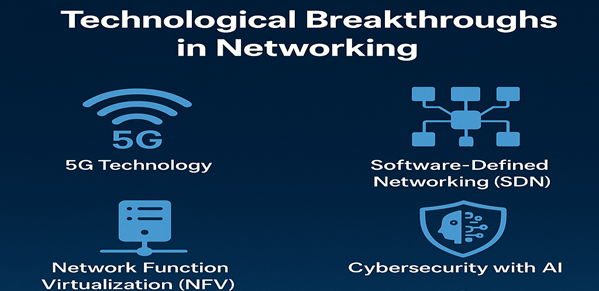The world is rapidly becoming digital now a days and the role of networking technology is like a backbone in it. Over time, there have been many major and revolutionary changes in the field of networking that have made the internet, data sharing, communication and security systems more effective, faster and safer than ever before.
We will shed light on some of the important advances in modern technology in the world of networking that have revolutionized infrastructure, business, education, banking and other sectors around the world.
Sure! Here’s the comparison table in English showing the key differences between traditional (old) networking and the latest modern networking technologies. You can directly use this in your blog:
Comparison Table: Traditional Networking vs Modern Networking Technologies
| Aspect | Traditional Networking | Modern Networking Technologies |
| Speed | Slow (e.g., 2G/3G), low data transfer rates | Ultra-fast (5G, Wi-Fi 6/7), Gigabit+ speeds |
| Connectivity | Limited device support, low bandwidth | Supports thousands of devices simultaneously |
| Security | Basic firewall and password protection | AI-powered security, encryption, real-time threat detection |
| Management | Manual configuration, complex setup | Centralized, software-defined (SDN), cloud-based control |
| Accessibility | Local or limited network access | Global access via cloud and remote networking |
| Intelligence | Low intelligence, user-dependent | AI integration, automated decision-making |
| Scalability | Expensive and difficult to scale | Highly scalable, cost-efficient |
| Virtualization | Hardware-dependent, limited flexibility | NFV (Network Function Virtualization), software-based |
| Latency | High latency, slower data response | Ultra-low latency, ideal for real-time applications |
| IoT Support | Little to no support | Fully compatible with IoT (smart homes, smart cities) |
- Latest 5G Technology in Networking
5G i.e. Fifth Generation Wireless Network has introduced new dimensions in the world of networking. It is many times faster than 4G, allowing for:
- Significantly increased download and upload speeds
- Zero latency
- Increased ability to connect smart devices like the Internet of Things (IoT)
- 5G has made the dream of remote surgery, autonomous vehicles, and smart cities a reality.
- Wi-Fi 6 and Wi-Fi 7
Modern Wi-Fi technologies like Wi-Fi 6 and the upcoming Wi-Fi 7 are revolutionizing home and commercial networking:
- These technologies can connect more devices at once
- Increased speed and improved network performance
- Lower power consumption and enhanced security features
- Wi-Fi 6E has begun using the 6GHz band, which was not possible before.
- Software Defined Networking (SDN)
SDN is a technology that has changed the fundamental concepts of networking. In it:
- The network is centrally controlled
- Network security and traffic management become easier due to advancement in networking
- Businesses can instantly change the network according to their needs
- This technology is very important for cloud computing and data centers.
- Network Function Virtualization (NFV)
With the help of NFV, software-based virtual services are used instead of expensive hardware. The advantage of this is that:
- Costs are reduced
- Network updates and scaling become easier
- Flexible Networking infrastructure is formed
- The role of artificial intelligence (AI) in cybersecurity
In view of the increasing security threats in networking, the use of artificial intelligence (AI) has now become common. AI:
- Can recognize suspicious behaviors and provide timely alerts
- Automatically blocks network attacks
- Continuously improves the security system
- The rise of the Internet of Things (IoT)
Now millions of devices in the world such as refrigerators, lights, fans, vehicles and doors are connected to the network. It is possible to control them remotely. The development of IoT is not possible without networking.
- Cloud Networking
The growing trend of cloud computing has made networking smarter Now:
- Data is accessible from anywhere
- Systems are better connected
- Businesses can run their services at lower cost
Conclusion
These amazing technological advancements in networking are not only making the world faster and more efficient, but they are also laying the foundation for more innovations in the future. The role of networking will become even more important in the future and every individual, organization and country should invest in it so that they do not get left behind in this digital era.
Are you curious about technology, tech lover, and want to know about latest technology related advancements you can visit hstech.io to boost your knowledge.
Tips:
- Keep an eye on networking updates
- Adopt modern security methods
- Understand and adopt new technologies like 5G, SDN, and AI
Absolutely! Here are 6 frequently asked questions (FAQs) in English related to the blog post on technological breakthroughs in networking:
Frequently Asked Questions (FAQs)
- What are the major advancements in modern networking technology?
Modern networking has seen innovations such as 5G, Wi-Fi 6/7, Software-Defined Networking (SDN), Network Function Virtualization (NFV), AI-powered cybersecurity, and the rise of IoT (Internet of Things).
- How is 5G better than previous generations of mobile networks?
5G offers significantly higher data speeds, ultra-low latency, and the ability to connect many devices at once—making it ideal for smart cities, autonomous vehicles, and remote surgeries.
- What is the role of AI in network security today?
Artificial Intelligence is used to detect, analyze, and respond to threats in real-time. It helps in proactive defense, anomaly detection, and reducing human error in cybersecurity.
- Why SDN is considered a game-changer in networking?
Software-Defined Networking (SDN) separates the control plane from the data plane, allowing centralized network management, automation, flexibility, and easier scaling.
- What benefits do Wi-Fi 6 and Wi-Fi 7 provide over older versions?
Wi-Fi 6/7 offer faster speeds, improved performance in crowded environments, lower latency, better battery efficiency for connected devices, and enhanced security.
- How does modern networking support IoT devices?
Modern networks like 5G and advanced Wi-Fi allow massive connectivity, seamless communication, and real-time responsiveness—enabling smooth functioning of IoT ecosystems like smart homes and industries.
































